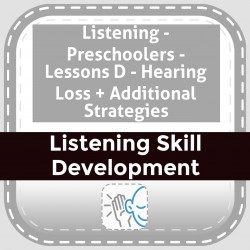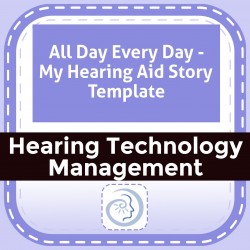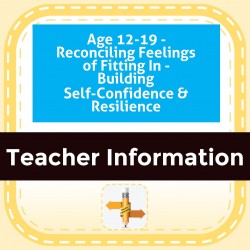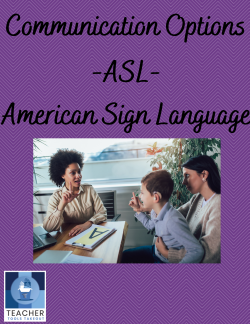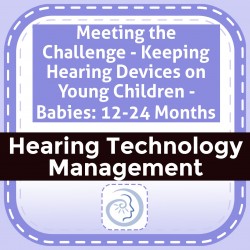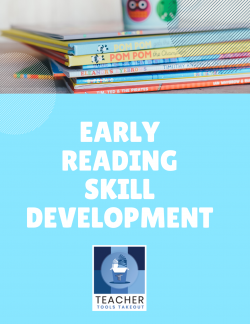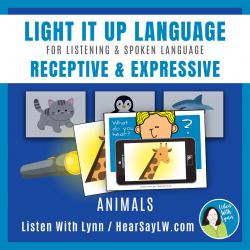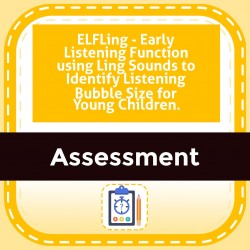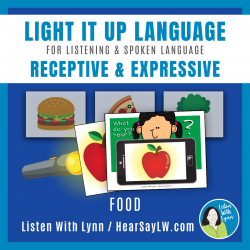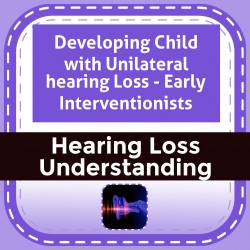Ability Levels
Categories
Resource Types
Age/Grade Range
CCSS
Anchor Standard
Speaking & Listening
Language
Reading
Listening - Preschoolers - Lessons D - Hearing Loss + Additional Strategies
$ 595
For teachers who work with early identified children with hearing loss. Includes fictional case studies with goals/objectives and specifically targeted activities to use with students who fit a partic
...
ular set of criteria in terms of hearing loss and device. Includes fillable lesson plans.
All Day Every Day - My Hearing Aid Story Template
$ 1
My Hearing Aid Book is a Word document designed for families or early intervention providers to insert photos of the child waking up, getting hearing aids put on, eating breakfast, etc. A good experie
...
nce story book to build language and good hearing aid wear practices.
Age 12-19 - Reconciling Feelings of Fitting In - Building Self-Confidence & Resilience
$ 250
For ages 12-19 years: This information addresses feelings of fitting in, problem-solving, social isolation, identity, importance of role models, positive outlook, and dealing with challenges due to he
...
aring loss. The purpose of this book is to raise awareness for the reasons why hearing device rejection happens and specific instruction to occur at different ages to build student resilience and self-confidence, thereby increasing the likelihood that they will not reject using their hearing technology. Specific teaching activities and recommendations for instructional materials to develop identified skills have been included in this Guide.
Communication Options - ASL - American Sign Language
$ 0
This resource explores the choice of ASL sign language for communication.
Meeting the Challenge - Keeping Hearing Devices on Young Children - Babies: 12-24 Months
$ 0
Brochure specifying what makes it challenging to keep hearing aids on 12-2400 month old babies, why hearing aids are needed, and strategies to help keep them on, including hearing aid retention device
...
s.
Early Reading Skill Development
$ 0
This resource includes two charts. The first provides the typical ages for development of each phonological awareness skill. The second provides the sequence of skills leading to literacy (auditory ba
...
sed).
ANIMALS Auditory Processing Receptive & Expressive Language
$ 5
You'll love the ANIMALS version of Light It Up Language! Kids listen to clues presented through hearing alone to identify 16 hidden ANIMALS vocabulary pictures. Each of the pictures has four clues th
...
ues that are increasingly more specific.The magic happens by lighting up the “What Do You Hear?” cards. Hidden pictures are held up to a flashlight and the ANIMALS images amazingly appear. How fun! Once the hidden picture is revealed the child recalls and uses the clues to describe the ANIMALS. Thereby stretching their auditory memory, descriptive language, and expressive language skills.TARGETS: RECEPTIVE: This game builds critical thinking and reasoning skills by categorizing, making inferences, and drawing conclusions. EXPRESSIVE: The child recalls and uses clues to describe the hidden object. INCLUDES:✧ Listening & language guide with instructions✧ Target or goal suggestions✧ 8 What Do You Hear? cards (printed twice)✧ 16 Hidden ANIMALS Picture Vocabulary Cards✧ 64 Prompt Clues - 16 objects with four details each that get increasingly more specific✧ A Script with scaffolding strategies✧ Listening and Spoken Language Tips ➼ EASY one-time quick game prep and you're all set to use year after year. ➼ You’ll need a FLASHLIGHT, a lamp, or a sunny window.◈ ◈ ◈ ◈ ◈ ◈ ◈ ◈ ◈ ◈ ◈ ◈ ◈ ◈ ◈ ◈ ◈ ◈ ◈ ◈ ◈ CUSTOMER TIPS:➼ Questions? Please email me before purchasing this resource or anytime later.♥ Sign-up HERE for the Listen With Lynn emails♥ For more ideas visit my blog: HearSayLW.comSTAY CONNECTED:✧ Sign-up here for the Listen With Lynn emails✧ Follow on Facebook - Lynn A. Wood - LSL Auditory Verbal Therapist and Rehab Audiologist✧ Follow on Instagram @auditoryverbal_listenwithlynn❤ Keep up your excellent work. I am blessed to help along the way. Thanks so much!Lynn Wood
ELFLing - Early Listening Function using Ling Sounds to Identify Listening Bubble Size for Young Children.
$ 0
Procedure to present Ling sounds at different distances in quiet/noise, near/far. Functional listening assessment to identify listening bubble for Ling speECH- sounds. Child response to Ling sounds -
...
pointing to images/toys, repeating sound, identifying images representing Ling sounds.
FOOD Auditory Processing Receptive & Expressive Language
$ 5
You'll love the FOOD version of Light It Up Language! Kids listen to clues to identify 16 hidden FOOD vocabulary pictures. Each of the pictures has four clues that are increasingly more specific.The m
...
magic happens by lighting up the “What Do You Hear?” cards. Hidden pictures are held up to a flashlight and the FOOD images amazingly appear. How fun! Once the hidden picture is revealed the child recalls and uses the clues to describe the FOOD. Thereby stretching their auditory memory, descriptive language, and expressive language skills.TARGETS: RECEPTIVE: This game builds critical thinking and reasoning skills by categorizing, making inferences, and drawing conclusions. EXPRESSIVE: The child recalls and uses clues to describe the hidden object. INCLUDES:✧ Listening & language guide with instructions✧ Target or goal suggestions✧ 8 What Do You Hear? cards (printed twice)✧ 16 Hidden FOOD Picture Vocabulary Cards✧ 64 Prompt Clues - 16 objects with four details each that get increasingly more specific✧ A Script with scaffolding strategies✧ Listening and Spoken Language Tips ➼ EASY one-time quick game prep and you're all set to use year after year. ➼ You’ll need a FLASHLIGHT, a lamp, or a sunny window.◈ ◈ ◈ ◈ ◈ ◈ ◈ ◈ ◈ ◈ ◈ ◈ ◈ ◈ ◈ ◈ ◈ ◈ ◈ ◈ ◈ CUSTOMER TIPS:➼ Questions? Please email me before purchasing this resource or anytime later.♥ Sign-up HERE for the Listen With Lynn emails♥ For more ideas visit my blog: HearSayLW.comSTAY CONNECTED:✧ Sign-up here for the Listen With Lynn emails✧ Follow on Facebook - Lynn A. Wood - LSL Auditory Verbal Therapist and Rehab Audiologist✧ Follow on Instagram @auditoryverbal_listenwithlynn❤ Keep up your excellent work. I am blessed to help along the way. Thanks so much!Lynn Wood
Developing Child with Unilateral hearing Loss - Early Interventionists
$ 19
This step‐by‐step guide has been developed to share with families after unilateral hearing loss has been diagnosed, typically in infancy secondary to identification through newborn hearing screening.
...
ng. The guide reviews background information regarding what is known about the effects of hearing loss in one ear on child development. It is divided into suggested sections to correspond with pediatric audiology appointments and with home visits by an early interventionist (teacher of the deaf/hard of hearing or speech language pathologist). Three is a focus on language and social development and a trial with amplification.
 Your browser is out of date. For best experience switch to latest updated Browser.
Your browser is out of date. For best experience switch to latest updated Browser.
 Get Chrome
Get Chrome Get Edge
Get Edge Get Firefox
Get Firefox